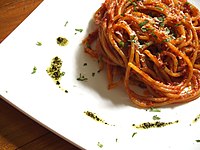Italian cuisine is characterized by its extreme simplicity, with many dishes having only four to eight ingredients. Italian cooks rely chiefly on the quality of the ingredients rather than on elaborate preparation.[10] Dishes and recipes are often the creation of grandmothers rather than of chefs, and this makes many recipes ideally suited for home cooking. This is one of the main reasons behind the ever increasing popularity of this cuisine, as cooking magazines in foreign countries popularize Italian recipes targeted at the home cook. Ingredients and dishes vary by region. Many dishes that were once regional, however, have proliferated with variations throughout the country. Cheese and wine are a major part of the cuisine, with many variations and Denominazione di origine controllata (DOC) (regulated appellation) laws. Coffee, specifically espresso, has become important in Italian cuisine. There are many Franco-Italians dishes such as Steak Florentine and Chicken Marsala.

No comments:
Post a Comment